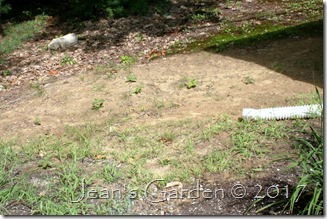 It was eight years ago today, that I clicked on “Publish” and sent the first post of Jean’s Garden, Welcome to My Garden, out into the world. In the years since, the garden has grown, and I have grown as a gardener.
It was eight years ago today, that I clicked on “Publish” and sent the first post of Jean’s Garden, Welcome to My Garden, out into the world. In the years since, the garden has grown, and I have grown as a gardener.
When I began the blog, my garden consisted of the circular bed at the turn into my driveway, the back slope, two small plantings along the front of the house (the iris bed and the bedroom border), and two large borders at the back of the house (the deck border and the blue and yellow border). A third flower bed for the back garden, the fence border, was under construction. By the time I prepared an overview diagram of the garden in January 2011 (see The Big Picture), the fence border had been completed and I was imagining another flower bed at the back of the garden, the serenity garden.
In the years since, not only has the serenity garden been created and a raised bed added to close off that area of the garden from the clothesline and driveway, but I have had an addition built on my house and embarked on a 5-year project to create a whole new front garden.
| Eight years ago, the front of my house looked like this. |  |
 |
Now it looks like this – and work on developing a lower garden below the retaining walls has just begun. |
As my garden has been growing during these past eight years, I have also been growing as a gardener; and blogging has been an important catalyst for that growth. Blogging put me in touch with other gardeners, both online and in person, from whom I have learned a great deal. (When I read some of my early blog posts, I’m sometimes embarrassed by my own ignorance.)
I found that writing about my garden process required that I reflect on it, and reflection led me to a better understanding of garden design (see, for example, Serendipity in Garden Design) and to reading books about garden design in greater depth and with more appreciation (e.g., Favorite Garden Books: The Inward Garden).
Participating in a series of Earth Day memes (see, for example, Books That Have Turned Me Green) led me into an interest in garden science. This is probably the greatest area of growth to result from my blogging experience, because I was a science-phobe when I was young. With the help of a botanist friend, I began to study and write about garden science (e.g., Botanical Identity Crisis). Since my retirement three years ago, I have been pursuing the study of horticultural science – by becoming certified as a Master Gardener Volunteer and through my work toward a Certificate in Native Plants and Ecological Horticulture from the Coastal Maine Botanical Gardens.
When I clicked on “Publish” eight years ago, I had no idea what I was getting into. I didn’t know how little I knew, or how much I would learn, or how much my life would be enriched by becoming a garden blogger.
Filed under: blogging, Garden, garden education Tagged: Coastal Maine Botanical Gardens, flower beds, garden blogs, Garden Books, garden design, Master Gardener Volunteers
![]()




















